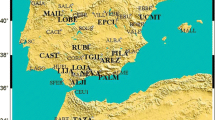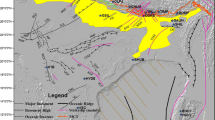Abstract
In order to study the ongoing tectonic deformation in the Rhine Graben area, we reconstruct the local crustal velocity and the strain rate field from GPS array solutions. Following the aim of this work, we compile the velocities of permanent GPS stations belonging to various networks (EUREF, AGNES, REGAL and RGP) in central western Europe. Moreover, the strain rate field is displayed in terms of principal axes and values, while the normal and the shear components of the strain tensor are calculated perpendicular and parallel to the strike of major faults. The results are compared with the fault plane solutions of earthquakes, which have occurred in this area.
A broad-scale kinematic deformation model across the Rhine Graben is provided on the basis of tectonics and velocity results of the GPS permanent stations. The area of study is divided into four rigid blocks, between which there might be relative motions. The velocity and the strain rate fields are reconstructed along their borders, by estimating a uniform rotation for each block. The tectonic behaviour is well represented by the four-block model in the Rhine Graben area, while a more detailed model will be needed for a better reconstruction of the strain field in the Alpine region.











Similar content being viewed by others
Notes
Swiss Federal Office of Topography
European reference frame (EUREF), automated GPS network for Switzerland (AGNES), Réseau GPS permanent dans les Alpes (REGAL), Réseau GPS Permanent (RGP).
1 nstrain/year corresponds to a change of distance of 1 mm per 1,000 km and year and is equivalent to 3.17×10−17 /s.
σ0 or sigma aposteriori, is a statistical parameter related to the residuals between real and estimated velocity values.
$$ \sigma _{0} = \frac{{{\sqrt {{\sum {P_{i} \operatorname{Re} sx_{i} ^{2} + P_{i} \operatorname{Re} sy_{i} ^{2} + P_{i} \operatorname{Re} sz_{i} ^{2} } }} }}} {{{\sqrt {n - u} }}} $$where P i is the weight of the I-velocity, calculated as
$$ P_{i} = {\left( {1 \mathord{\left/ {\vphantom {1 {{\left( {\sigma ^{2}_{{V_{{{\text{north}}_{i} }} }} + \sigma ^{2}_{{V_{{{\text{east}}_{i} }} }} } \right)}}}} \right. \kern-\nulldelimiterspace} {{\left( {\sigma ^{2}_{{V_{{{\text{north}}_{i} }} }} + \sigma ^{2}_{{V_{{{\text{east}}_{i} }} }} } \right)}}} \right)} $$and \( \sigma _{{V_{{north_{i} }} }} \) and \( \sigma _{{V_{{east_{i} }} }} \) the standard deviation for the two components of the horizontal velocity, that we assumed equal to 1mm/√year, Re sx i , Re sy i , Re sz i are the difference (residuals) between the real and calculated geocentric velocities with the four block model at the GPS stations, n is the number of observations and u the number of unknowns.
The correlation function defines the interrelationship between different points observed. Normally, the influence of a distant point should be smaller and the value of the function usually decreases with a growing distance and converges to zero. Therefore, if a correlation length is chosen too short the values observed remain isolated, while if it is too long, the field derived becomes extremely smooth. However, a correlation length should not be smaller than the average distance between the stations (Straub 1996).
References
Ahorner L (1975) Present-day stress field and seismotectonic block movements along major fault zones in central Europe. Tectonophysics 29:233–249
Altamimi Z, Sillard P, Boucher C (2002) ITRF2000: A new release of the International Terrestrial Reference Frame for earth science applications. J Geophys Res 107, B10 2214:1–19
Bada G, Cloetingh S, Gerner P, Horvath F (1998) Sources of recent tectonic stress in the Pannonian region: inferences from finite element modeling. Geophys J Int 91:937–983
Bassi G, Sabadini R, Rebaï S (1997) Modern Tectonic regime in the Tyrrenian area: observations and models. Geophys J Int 129:330–346
Behrmann JH, Hermann O, Horstmann M, Tanner DC, Bertrand G (2003) Anatomy and kinematics of oblique continental rifting revealed: a three-dimensional case study of the southeast Upper Rhine graben (Germany). AAPG Bull 87(7):1105–1121
Beutler G, Bock H, Brockmann E, Dach P, Fridez P, Gurtner W, Hugentobler U, Ineichen D, Johnson J, Meindl M, Mervart L, Rothacher M, Schaer S, Springer T, Weber R (2001) In: Hugentobler U, Shaer S, Fridez P (eds) Bernese GPS Software Version 4.2. Astronomical Institute, University of Berne
Bonjer K-P (1997) Seismicity pattern and style of seismic faulting at the eastern borderfault of the southern Rhine Graben. Tectonophysics 275:41–69
Brockmann E, Grünig S, Schneider D, Wiget A, Wild U (2001) Introduction and first applications of a Real Time Precise Positioning Service using the Swiss Permanent Network ‘AGNES’. National report of Switzerland: In: Torres JA, Hornik H (eds) Subcommission for the European Reference Frame (EUREF). Dubrovnik, 2001
Brockmann E, Grünig S, Schneider D, Wiget A, Wild U (2002) Applications of the real-time Swiss GPS permanent network AGNES. In Proceedings of the EGS XXVII general assembly, Nice, 21–26 April 2002, Session 9 on Evolving Space Geodesy Techniques, Physics and Chemistry of the Earth
Calais E, Gallison L, Stéphan J-F, Delteil J, Deverchere J, Larroque C, Mercier De Lépinay B, Popoff M, Sosson M (2000) Crustal strain in the Southern Alps, France, 1948–1998. Tectonophysics 319:1–17
Calais E, Noquet J-M, Jouanne F, Tardy M (2002) Current strain regime in the Western Alps from continuous Global Positioning System measurements, 1996–2001. Geology 30(7):651–654
Delacou B, Sue Ch, Champagnac JD, Burkhard M (2004) Present-day geodynamics in the bend of the western and central Alps as constrained by earthquake analysis. Geophys J Int 158:753–774
Delouis B, Haessler H, Cisternas A, Rivera L (1993) Stress tensor determination in France and neighbouring regions. Tectonophysics 221:413–438
Eva E, Solarino S, Eva C, Neri G (1997) Stress tensor orientation derived from fault plane solutions in the southwestern Alps. J Geophys Res 102(B4):8171–8185
Eva E, Pastore S, Deichmann N, (1998) Evidence for ongoing extensional deformation in the western Swiss Alps and thrust-faulting in the southwestern Alpine Foreland. J Geodynam 26(1):27–43
Eva E, Solarino S (1998) Variations of stress directions in the western Alpine arc. Geophys J Int 135:438–448
Geiger A (2003) Präzisionsnavigation. Lecture Notes Geomatics, ETH Zürich
Giamboni M, Ustaszewski K, Schmid SM, Schumacher ME, Wetzel A (2004) Plio-Pleistocene transpressional reactivation of Paleozoic and Paleogene structures in the Rhine-Bresse transform zone (northern Switzerland and eastern France). Int J Earth Sci 93(2):207–223
Glahn A, Granet M (1992) 3-D structure of the lithosphere beneath the southern Rhine Graben area. Tectonophysics 208:149–158
Grenerczy G, Kenyeres A, Fejes I (2000) Present crustal movement and strain distribution in Central Europe inferred from GPS measurements. J Geophys Res 105(B9):21835–21846
Kahle H-G, Cocard M, Peter Y, Geiger A, Reilinger R, Barka A, Veis G (2000) GPS-derived strain field within the boundary zones of the Eurasian, African, and Arabian Plates. J Geophys Res 105(B10): 23353
Kastrup U. (2002) Seismotectonics and stress field variations in Switzerland. PhD Thesis, no. 14527, ETH Zürich
Kastrup U, Zoback ML, Deichmann N, Evans KF, Giardini D, Andrew JM (2004) Stress field variations in the Swiss Alps and the northern Alpine foreland derived from inversion of fault plane solutions. J. Geophys Res 109(B1):B01402
Larroque JM, Laurent PH (1988) Evolution of the stress field pattern in the south of the Rhine Graben from the Eocene to the present. Tectonophysics 148:41–58
Larroque JM, Etchecopar A, Philip H (1987) Evidence for the permutation of stresses σ1 and σ2 in the Alpine foreland: the example of the Rhine Graben. Tectonophysics 144:315–322
Laubscher H (1982) Die Südostecke des Rheingrabens-ein kinematisches und dynamisches Problem Eclogae Geol. Helvetica 75:101–116
Mälzer H, Schlemmer H (1975) Geodetic measurements and recent crustal movements in the southern upper Rhinegraben. Tectonophysics 29:275–282
Meghraoui M, Delouis B, Ferry M, Giardini D, Huggenberger P, Spottke I, Granet M (2001) Active normal faulting in the Upper Rhine Graben and Paleoseismic identification of the 1356 basel earthquake. Science 293:2070–2073
Müller B, Zoback ML, Fuchs K, Mastin L, Grgersen S, Pavoni N, Stephanson O, Ljundggren C (1992) Regional pattern of tectonic Stress in Europe. J Geophys Res 97(B8):11783–11803
Nicolas M, Santoire JP, Delpech PY (1990) Intraplate seismicity: new seismotectonic data in Western Europe. Tectonophysics 179:27–53
Noquet JM, Calais E (2003) Crustal velocity field of western Europe from permanent GPS array solutions, 1996–2001. J Geophys Res 154:72–88
Pavoni N (1980) Crustal stresses inferred from fault-plane solutions of earthquakes and neotectonic formation in Switzerland. Rock Mech Suppl 9:63–68
Plenefisch T, Bonjer KP (1997) The stress field in the Rhine graben area inferred from earthquake focal mechanisms and estimation of frictional parameters. Tectonophysics 275:71–97
Rózsa Sz, Heck B, Mayer M, Seitz K, Westerhaus M, Zipelt K (2003) Determination of displacements in the Upper Rhine Graben area from GPS and levelling data. Int J Earth Sci (this issue)
Schlatter A, Schneider D, Geiger A, Kahle H-G (2003) Recent vertical movements from precise levelling in the vicinity of the city of Basle, Switzerland. Int J Earth Sci (this issue)
Schumacher ME (2002) Upper Rhine Graben: Role of preexisting structures during rift evolution. Tectonics 21, 1,1006:1–17
Straub Ch. (1996) Recent crustal deformation and strain in the Marmara Sea region, NW Anatolia inferred from GPS Measurements. Ph.D. thesis, ETH Zürich
Sue C, Thouvenot F, Fréchet J, Tricart P (1999) Widespread extension in the core of the western Alps revealed by earthquake analysis. J Geophys Res 104(B11):25611–25622
Sue C, Tricart P (2003) Neogene to ongoing normal faulting in the inner western Alps: a major evolution of the late alpine tectonics. Tectonics 22, 5, 1050:1–25
Vigny C, Chéry J, Duquesnoy T, Jouanne F, Amman J, Anzdei M, Avouac J-P, Barlier F, Bayer R, Briole P, Calais E, Cotton F, Duquenne F, Feigl KL, Ferhat G, Flouzat M, Gamond J-F, Geiger A, Harmel A, Kasser M, Laplanche M, Le Pape M, Martinod J, Ménard G, Meyer B, Ruegg J-C, Scheubel J-M, Scotti O, Vidal G (2002) GPS network monitors the Western Alps’ deformation over a five-year period: 1993–1998. J Geodesy 76:63–76
Villemin T, Alvarez F, Angelier J (1986) The Rhinegraben: extension, subsidence and shoulder uplift. Tectonophysics 128:47–59
Ziegler PA (1992) European cenozoic rift system. Tectonophysics 208:91–111
Ziegler PA, Dèzes P (2003) The Rhine rift system: evolution of the lithosphere. Int J Earth Sci (in this issue)
Zippelt K, Mälzer H (1981) Recent height changes in the central segment of the Rhinegraben and its adjacent shoulders. Tectonophysics 73:119–123
Acknowledgments
We would like to thank Nicholas Deichmann of the Swiss Seismological Service for the helpful discussions and for providing the program to convert the azimuth and dip values of P and T axes to azimuth dip and rake values of the principal planes of focal mechanisms. We wish to thank the two reviewers Malte Westerhaus of Karlsruhe University and Stefan Schmid of Basel University, for helpful comments that improved the manuscript. Funds were kindly provided by EU grant HPRN-2000-00053 (Swiss Federal Office of Science and Education, BBW N0. 99-0567-2) within the framework of the project ENTEC.
Author information
Authors and Affiliations
Corresponding author
Additional information
Magdala Tesauro: now at Faculty of Earth and Life Sciences, Vrije Universiteit Amsterdam , De Boelelaan 1085 1081 HV Amsterdam , e-mail magdala.tesauro@falw.vu.nl
Ramon Egli: now at Institute for Rock Magnetism University of Minnesota, 291 Shepherd Laboratories, 100 Union Street, S.E. Minneapolis, MN 55455-0128
Rights and permissions
About this article
Cite this article
Tesauro, M., Hollenstein, C., Egli, R. et al. Continuous GPS and broad-scale deformation across the Rhine Graben and the Alps. Int J Earth Sci (Geol Rundsch) 94, 525–537 (2005). https://doi.org/10.1007/s00531-004-0453-0
Received:
Accepted:
Published:
Issue Date:
DOI: https://doi.org/10.1007/s00531-004-0453-0




